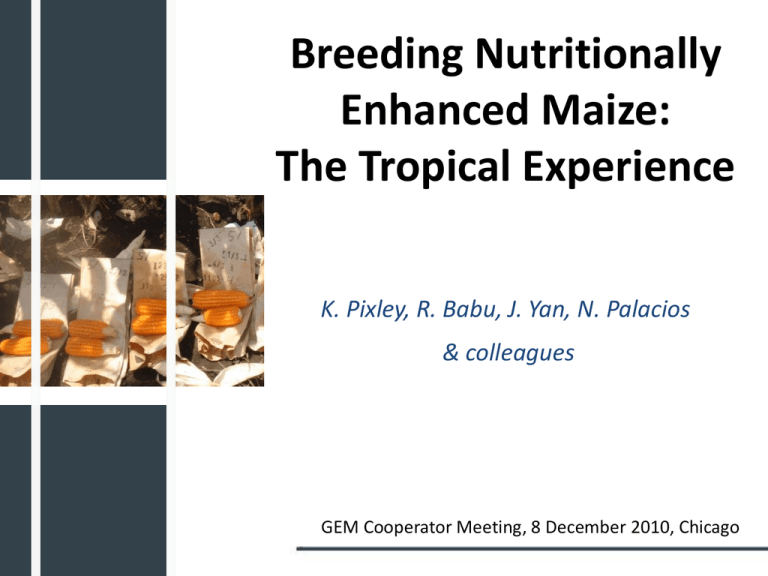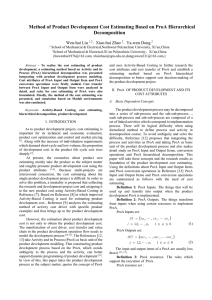Breeding Nutritionally Enhanced Maize: The Tropical Experience
advertisement

Breeding Nutritionally Enhanced Maize: The Tropical Experience K. Pixley, R. Babu, J. Yan, N. Palacios & colleagues GEM Cooperator Meeting, 8 December 2010, Chicago QPM: Nutritionally enhanced maize “The Pigs” QPM also “works” with chickens… QPM Pellagra: diarrhea, dermatitis; due to niacin deficiency. Tryptophan is a precursor of niacin Kwashiorkor: edemas, anorexia, increased susceptibility to infections; due to low quality protein Normal Maize What is QPM? • Contains one gene – opaque2 (o2) – that affects protein production in the grain – No change in protein quantity – More of proteins rich in tryptophan and lysine • o2 was found in maize; QPM is not transgenic • Looks, cooks and tastes like normal maize • Must be, and many are, agronomically competitive Where is maize an important source of protein? FAO Stat WHO, 2007. Protein and amino acid requirements in human nutrition. http://whqlibdoc.who.int/trs/WHO_TRS_935_eng.pdf Summary: QPM meta-analysis Gunaratna et al. • 9 studies: 5 countries (Ethiopia, Ghana, India, Mexico, Nicaragua); 48-486 children; 3.5 mo – 5 yr old • Consuming QPM instead of normal maize resulted in: – 12% (95% CI: 7-18%) increase in weight gain – 9% (95% CI: 6-15) increase in height gain These results were robust; essentially unchanged by: Various adjustments/transformations to the data, or methods to calculate CI Discard studies with most extreme results Discard any of the studies Gunaratna et al., Food Policy 2010 Iron deficiency affects >2 billion people • Iron deficiency anemia (IDA) – Maternal and perinatal mortality – Impaired cognitive skills and physical activity • Women and children in South Asia and Africa Zinc deficiency • Zn deficiency – 800,000 child deaths per year; increased risk • Diarrhea, pneumonia, malaria – Stunting during early childhood – Equally affects males and females – South Asia and Africa Photo: N. Palacios Vitamin A deficiency • Vitamin A deficiency (VAD) – Night blindness, corneal scarring & blindness – Weakened immune system: VAD associated with • 20% of measles• 24% of diarrhea• 20% of malaria-related mortality in children; • 20% of maternal mortality – South Asia and Africa have highest VAD prevalence – 157 million pre-school children – 30 million pregnant women * Micronutrient malnutrition affects more than half of the world’s population – United Nations SCN, 2004. Dietary sources • Vitamin A – Meat (esp. liver) – Vegetables (carrot, sweet potato, spinach) • Iron – Red meat, fish, poultry – Lentils, beans, leafy vegetables • Zinc – Oysters, animal proteins, – Beans, nuts, whole grains Rural Bangladesh Share of expenditures before price rise $$$ $ Staples Animal Nonstaple plants $$$$ $$ Share of expenditures after price rise Staples Meat & Fish Non-Food Non-staple plants Meat & Fish Non-Food Biofortification of staple food crops • Micronutrients available in staple foods – Sustainable, affordable – Accompanied by dietary/nutrition information – Complemented by supplementation and fortification • Acute malnutrition • Equal or better agronomic performance of biofortified crops – Yield, disease resistance, drought tolerance… Cross high proA x good drought tolerance… De3, SC55, CI7 BC1S1 X X X X X XX BC1S2 BC1S4 2nd Dose F1’s BC1 2nd Dose S1’s X X X 8 promising proA hybrids: 5 sites in Zambia + 2 sites in Zimbabwe Tons per hectare Best hybrid check ProA (ug/g) Hybrid 1: 8.9 Hybrid 2: 7.1 Hybrid 3: 6.3 Hybrid 4: 6.5 Hybrid 5: 7.4 Hybrid 6: 5.7 Hybrid 7: 6.9 Hybrid 8: 5.9 LCYE affects the ratio of carotenoids in the biosynthetic pathway GGPP PSY PDS Z-ISO ZDS/CRISTO 1. Alleles for LCYE identified by: Association mapping Linkage mapping LCYE lycopene δ-carotene Expression analysis LCYB Mutagenesis α-carotene HYDb zeinoxanthin Harjes et al., Science 2008 HYDE lutein 2. HYDB1 has a large effect on BC Yan et al., Nature Genetics 2010 LCYB γ-carotene LCYB β-carotene HYDb1 β-cryptoxanthin HYDb zeaxanthin ABA De3 (KU1409/DE3/KU1409)S2-18-2-B Total proA (ug/g) in 9 genotypic classes of 6 crosses LycE 4 HydB 1 4 2 4 H 2 1 2 2 2 H H 1 H 2 H H Pop 1 5.60 5.74 7.41 7.40 2.08 2.06 4.16 4.11 9.45 9.47 3.58 3.59 4.83 4.87 Pop 2 12.03 11.94 4.27 4.09 6.17 11.11 10.74 3.36 3.34 4.07 4.07 12.96 13.20 4.14 4.21 6.82 6.80 Pop 3 9.97 9.70 4.78 4.73 7.19 6.92 3.73 3.71 5.30 5.40 Pop 4 Pop 5 6.15 6.12 3.46 3.99 3.57 4.08 7.42 7.51 6.25 6.19 2.60 4.28 2.50 4.33 3.88 4.42 3.89 4.43 5.08 4.98 3.95 4.13 5.41 5.41 B104 CML325, CML327, CML460 Pop 6 5.74 5.75 3.90 3.74 5.10 5.09 3.31 3.29 3.88 3.93 3.64 3.60 Bank accessions (hets) KUI carotenoid syn-FS17-3-2-B Seed genotyping pre-planting Dry chipping using dog nail clippers ≈10,000 seeds will be genotyped pre-planting this season Steps to develop a hybrid cultivar (w/MAS) year 1 UU x FF -> UF Elim.50% UF x UU -> UU:UF 200UF seeds -> 50UU:100UF:50FF 2 50FF S1 ears -> 40FF S2 ears 1-2 best S6 x 3 tester -> 15 Stage3 hyb 5 S7 -> HPLET 75% 40FF x tester -> 15 stage1 hybrids 3 15 best S3 -> 15 best S4 4-5 best x tester -> hyb 6 Multilocation on-farm trials 1-2 best -> release 7 Multilocation on-farm demo’s 8 Begin marketing seed $10 15 S4 (HPLC) x 3 tester -> 15 Stage2 hyb per 4 5 best S5 -> 5 best S6 row + time $5850 $25150+120+45 nursery 75/sa + (45x6) trial rows mple $2250 What happens to provitamin A during cooking? Photo: N. Palacios Photo: H. De Groote Effect of porridge preparation Shanshan Li et al., 2007 25% loss of β-carotene Effect of snack preparation • 36% loss of provitamins A following nixtamalization and snack preparation by deep frying (n=13) Lozano Alejo et al., 2006 What happens to provitamin A after we eat them? …bioaccessibility In vitro assessment of bioaccessibilty of carotenoids from foods Parker, FASEB J, 1996 Mark Failla Department of Human Nutrition KUI carotenoid syn-FS17-3-1-B-B/CML356-B 20.5 41.1 Combining proA and Zn …bioefficacy 21.1 37.7 KUI carotenoid syn-FS17-3-1-B-B/(CML-356 x GWIB) -1-23TL-1-2-1-B dehydrogenase Vision KUI carotenoid syn-FS17-3-2-B-B/CML353-B retinal retinol 19.7 32.0 Zn in the action of retinol dehydrogenase KUI carotenoid syn-FS17-3-2-B-B/(CML-239 x GWIC) -1-7TL-1-1-1-B 18.7 for 32.5 monooxygenase (retinol to retinal); essential pigment Digestion -carotene 2 retinal Zn KUI carotenoid syn-FS17-3-2-B-B/CML355-B vision 15.8 29.8 KUI carotenoid syn-FS17-3-2-B-B/CML356-B Zn is a probable co-factor for b-carotene 22.4 35.2 KUI carotenoid syn-FS17-3-2-B-B/(CML-356 x GWIB) -1-23TL-1-2-1-B mono-oxygenase (cleaves proA to23.1 vitA)33.2 Protein synthesis retinol binding protein retinol:RBP in blood KUI carotenoid syn-FS25-3-2-B-B/CML353-B Zn deficiency depresses synthesis22.9 of the (RBP) 33.0 carrier protein of vitA => lower plasma KUI carotenoid syn-FS25-3-2-B-B/(CML-239 x GWIC) -1-7TL-1-1-1-B 22.0 31.9 retinol concentrations 0.5 0.5 0.3 Zn Zn KUI carotenoid syn-FS25-3-2-B-B/P903 C0 H364-1-8TL-3-2-1-1-B-B-B-B-B -B 0.5 0.2 2.0 2.0 2.0 2.1 19.8 29.3 0.3 KUI carotenoid syn-FS25-3-2-B-B/(CML-356 x GWIB) -1-23TL-1-2-1-B ppm 22.6 ppm 29.8 ppm 0.5 KUI carotenoid syn-FS17-3-1-B-B/CML353-B Carotenoid Syn3-FS5-1-5-B-B/CML353-B 18.1 20.5 33.3 28.6 0.6 KUI carotenoid syn-FS17-3-1-B-B/(CML-239 x GWIC) -1-7TL-1-1-1-B 17.9 34.8 0.3 20.5 41.1 0.5 KUI carotenoid syn-FS17-3-1-B-B/(CML-356 x GWIB) -1-23TL-1-2-1-B 17.2 23.1 0.4 CML-304-B-B/CML353-B KUI carotenoid syn-FS17-3-2-B-B/CML353-B 14.5 19.7 26.0 32.0 0.3 0.3 KUI carotenoid syn-FS17-3-2-B-B/(CML-239 x GWIC) -1-7TL-1-1-1-B Average 20.4 18.7 31.6 32.5 0.8 0.5 2010: Stage 1 High Zn x ProA KUI carotenoid syn-FS17-3-2-B-B/CML356-B 2011: S2’s High Zn x ProA (HYDB1) to TC 15.8 29.8 0.2 22.4 35.2 2.0 Pedigree Carotenoid Syn3-FS5-1-5-B-B/CML355-B KUI carotenoid syn-FS17-3-1-B-B/CML356-B CML-305-B-B/CML356-B KUI carotenoid syn-FS17-3-2-B-B/CML355-B Fe 32.0 21.1 Zn 32.9 37.7 Al 0.6 0.6 0.5 Will farmers and consumers grow/ consume biofortified crops? • ProA sweet potatoes are orange; consumers prefer white • Will farmers choose to plant the biofortified varieties? • Will farmers choose to grow orange maize varieties? • Will seed companies market the new orange varieties? No complaints from these consumers! Agriculture for nutrition and health + 0.00 13.698 0.02 10.578 11.517 0.04 9.183 0.06 6.717 7.024 7.217 7.957 + 3.332 3.961 4.485 4.750 + + AU 0.08 18.859 0.10 16.246 5.473 0.12 -0.02 2.00 Plant breeding and agronomy Education & marketing + 8.00 10.00 12.00 14.00 Minutes 16.00 18.00 20.00 22.00 24.00 + + + Socio-economics 6.00 Plant biochemistry Molecular biology + 4.00 Nutrition Healthy families Food technology Seeds of Discovery (SeeD) A Mexican initiative to contribute to global food security vis-à-vis climate change and resource scarcity by broadening the genetic base of global maize and wheat-breeding programs P. Wenzl, K. Pixley, G. Atlin, G. Edmeades, M. Banziger & many colleagues Historical bottleneck 10 – 20 years Genetic resources Breeding programs SeeD: new genetic variation to raise future crop production Variety adoption and improvement Increased agricultural production Factors limiting the use of GR Factor 1: So many accessions, so little information! – Challenges to characterize accessions at phenotypic and molecular levels – Missing or ‘superficial’ passport data Factor 2: Insufficient tools to mine information Many of the same – Outdated/user-unfriendly data management tools challenges and – Limited query capabilities issues of GEM! Factor 3: How to effectively utilize exotic germplasm? – How to identify beneficial alleles in exotic germplasm? – How to capture novel, useful variation into elite backgrounds Objectives of SeeD Objective 1: To mine maize/wheat genetic resources for novel alleles and beneficial traits combining genotyping and phenotyping methods Objective 2: To build on-line catalogues that facilitate the identification of beneficial genetic variation, and Objective 3: To put in place practical delivery pathways that empower maize and wheat programs to broaden their genetic base by incorporating novel variation Marker-assisted introgression pipeline service facility Doubled haploid service facility? Develop and release “bridging lines” SeeD: A technology intensive project! Because of the size and complexity of the initiative, will require strategic alliances with key players. Key partnerships: 1. Genotyping 2. Phenotyping 3. High-performance bioinformatics approaches for genetic analyses 4. Cyberinfrastructure for a SeeD web portal Concept-development guidelines: Focus on user base targeted by SeeD: maize and wheat breeding programs, especially public and SME breeding programs in developing countries Design practical delivery paths that enable the adoption of novel and useful genetic diversity in breeding programs. Draft strategy for maize General points (and working assumptions) • The CIMMYT maize collection has about 26,000 accessions with no genotypic data, incomplete passport data, and some phenotypic data • Most accessions are heterogeneous with much more genetic variability among than within accessions. • Alleles that are rare globally, and at low frequencies in the accessions in which they occur, are unlikely to be very important or detectable. • Most traits in maize are highly polygenic. • Haplotypes with small effects likely control most variation General points (cont’d) • Main diversity is to be found in the Mexican-Guatemalan germplasm, which has been in long co-existence with teosinte • Much genetic variability remains in teosinte, but there are few introgression populations available that could allow us access to this variability • Demand for direct access to landrace or teosinte accessions by breeders will be limited Two main products of SeeD for maize • Haplotype effect estimates for loci with small effects • Well-characterized accessions for specific traits to be used as donors for large-effect alleles Haplotypes as the unit of evaluation • • Because haplotypes are likely to be replicated across many accessions, it is the haplotype rather than the accession itself whose effect we want to estimate, and that is the unit of evaluation or selection To sample haplotype frequencies and to begin estimating haplotype effects, one plant per accession will be initially genotyped at >1,000,000-plex, on the assumption that this would detect all but the rarest alleles Test crosses • To estimate haplotype allele effects, the single-plant representatives of core accessions will be crossed to elite, adapted testers (testers as females) • The testcrosses will be phenotyped in screens of interest. GEBV prediction for all accessions • Because haplotypes will usually be replicated across accessions, it not necessary to estimate the effect of each testcross with high precision via high levels of replication on individual accessions. • Based on allelic effects estimated by phenotyping the subset of core accessions, the entire collection will be examined for accessions that have high GEBVs for traits of interest, and that are under-sampled in the existing elite germplasm. • New pre-breeding populations will be established from these accessions and improved by genomic selection. “Details of this approach to delivery of new genetic variation for quantitative traits needs a lot more thought…” Large-effect alleles • The objective is to identify accessions with high frequencies of unusual alleles with large effects on simple or oligogenic traits. There will likely be very few of these. • The accession is the unit of evaluation • The core and materials that have a high likelihood of having been selected for the trait (based on passport information) need to be phenotyped at high precision, either per se or in testcrosses. Large-effect alleles • Map, and develop gene-based markers • Introgress the allele of interest into elite inbreds (“bridge inbreds”), which breeding programs will be want to use • As donors for MAS-based conversion, or • As parents of pedigree starts. • SeeD probably needs to develop such inbreds as deliverables, to ensure that any genes discovered are truly accessible to smaller public and private breeding programs in the developing world SeeD and GEM Many opportunities for complementarity and partnership with GEM Important to communicate often and learn from each other Many questions we can work together to answer and enhance the use of genetic resources P.Wenzl@cgiar.org G.Atlin@cgiar.org K.Pixley@cgiar.org









